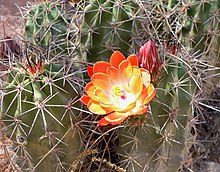Echinocereus arizonicus
| Echinocereus arizonicus | |
|---|---|

| |
| Scientific classification | |
| Kingdom: | Plantae |
| Clade: | Tracheophytes |
| Clade: | Angiosperms |
| Clade: | Eudicots |
| Order: | Caryophyllales |
| Family: | Cactaceae |
| Subfamily: | Cactoideae |
| Genus: | Echinocereus |
| Species: | E. arizonicus
|
| Binomial name | |
| Echinocereus arizonicus | |

| |
| Synonyms[2] | |
| |
Echinocereus arizonicus [3] is a species of cactus native to the Chihuahuan Desert region of Chihuahua, southwestern New Mexico and southeastern Arizona, as well as in the Superstition and Mescal Mountains of Central Arizona at elevations between 1400 to 1900 meters.[4]
Description
[edit]Plants grow in small clumps. Stems are cylindric with 8–13 ribs, measuring 10 cm–40 cm × 5 cm–10 cm (3.9 in–15.7 in × 2.0 in–3.9 in). Areoles are spaced 10–15 mm (0.39–0.59 in) apart. Spines vary, being straight or contorted. Each areole has 1–8 central spines, 15–50 mm (0.59–1.97 in) long, and 7–14 radial spines, 5–25 mm (0.20–0.98 in) long, initially yellowish to brownish but turning gray. Echinocereus arizonicus has deep red to bright orange-red flowers, sometimes with a lighter yellowish-green center.[2][5], 5.5 cm–7 cm × 3.5 cm–5 cm (2.2 in–2.8 in × 1.4 in–2.0 in), with a flower tube of 25–35 mm (0.98–1.38 in) that has short spines and 2 mm (0.079 in) hairs. Fruits are green with a brownish tinge, 20–30 mm (0.79–1.18 in), and have white pulp. The chromosome count is 2n = 22.[6]
Distribution
[edit]Plants are found growing in desert scrub and grasslands of the Chihuahuan Desert in Arizona, New Mexico in the United States and Chihuahua, Mexico at elevations between 1400 to 1900 meters.[7] Plants are found growing along with Quercus turbinella, Quercus emoryi, Arctostaphylos pungens, Cercocarpus montanus, Nolina microcarpa, Dasylirion wheeleri, Agave chrysantha, Muhlenbergia emersleyi, Pinus monophylla, Juniperus pinchotii and Rhus trilobata.[8][9]
-
Plant growing in South Mountain Park in Phoenix, Arizona
-
Blooming Plant in Tonto National Forest
Taxonomy
[edit]Common names include "Arizona claret-cup cactus" and "Arizona hedgehog cactus."[2]
References
[edit]- ^ Baker, M. (2017) [amended version of 2013 assessment]. "Echinocereus arizonicus". IUCN Red List of Threatened Species. 2017: e.T152305A121468353. doi:10.2305/IUCN.UK.2017-3.RLTS.T152305A121468353.en. Retrieved 25 April 2023.
- ^ a b c "Echinocereus arizonicus in Flora of North America @ efloras.org". www.efloras.org. Retrieved 2016-12-16.
- ^ Orcutt, C.R. Cactography. 1926 (1): 3. 1926.
- ^ Center for Plant Conservation, National Collection of Imperiled Plants, Echinocereus triglochidiatus var. arizonicus.
- ^ "ASDM Sonoran Desert Digital Library". Arizona-Sonora Desert Museum Digital Library. Retrieved 2016-12-16.
- ^ "Echinocereus arizonicus". beta.floranorthamerica.org. 2020-11-05. Retrieved 2024-06-23.
- ^ "All Arizona Species; Arizona Hedgehog Cactus Var. Echinocereus triglochidiatus arizonicus" (PDF). www.fws.gov. Retrieved 2016-08-27.
- ^ "CPC Plant Profile: Arizona Hedgehog Cactus". Center for Plant Conservation. 2015-05-03. Retrieved 2024-08-02.
- ^ "Echinocereus arizonicus". SEINet Portal Network. Retrieved 2024-08-02.
External links
[edit] Media related to Echinocereus arizonicus at Wikimedia Commons
Media related to Echinocereus arizonicus at Wikimedia Commons Data related to Echinocereus arizonicus at Wikispecies
Data related to Echinocereus arizonicus at Wikispecies



